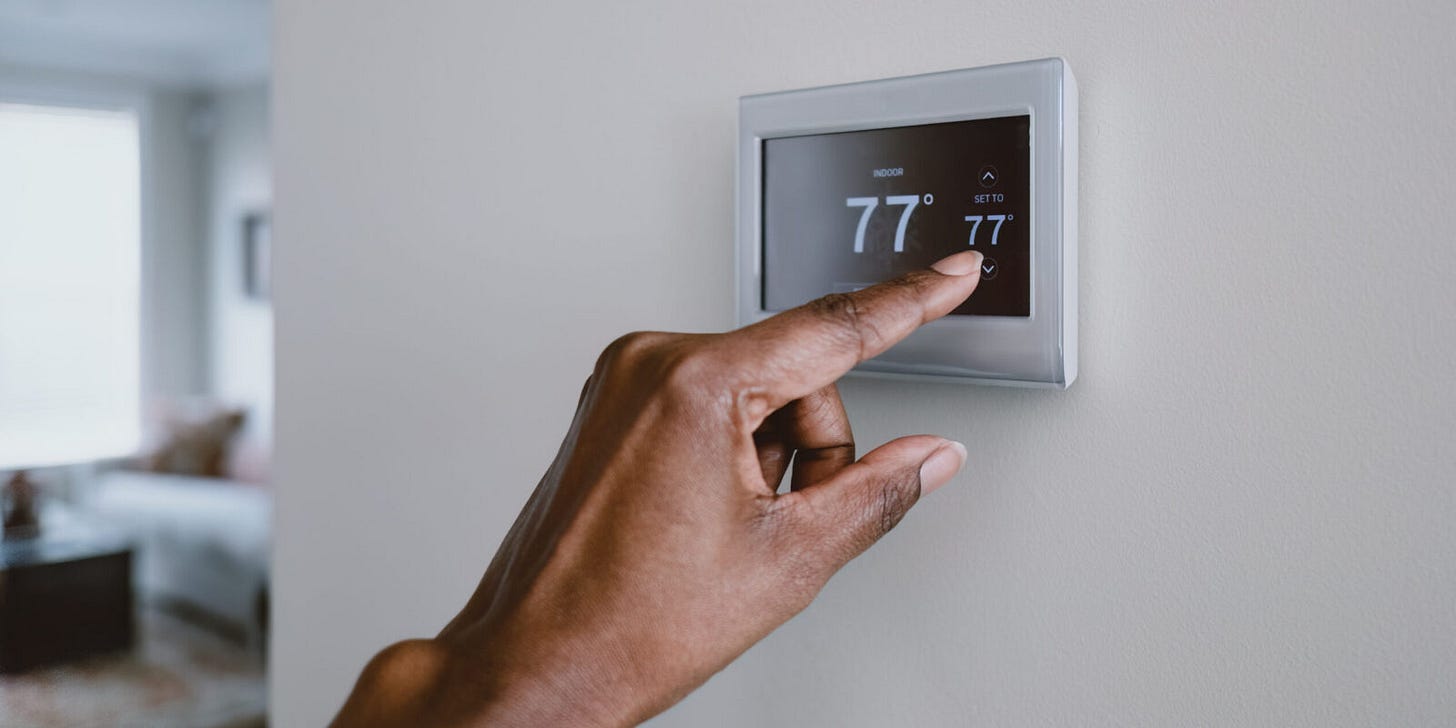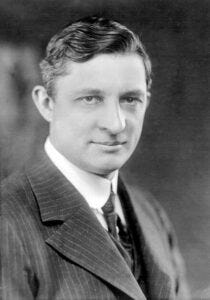The Man Who Manufactured Weather
At the height of a hot summer, show a little gratitude to Willis Carrier, the inventor of modern air-conditioning

The heat wave of 1901 was brutal across the eastern United States, setting some records that persist to this day. One of these occurred in St. Louis where, according to a recent retrospective in the St. Louis Post-Dispatch, “For nearly seven weeks, temperatures were above 90 on all but three days. It was 100 or hotter on 15 days, including a terrible four-day run of at least 106.”
At a time when the electric ceiling fan was a new invention, there was little hope for relief. To relieve the suffering, the Post-Dispatch raised funds from its readers to distribute ice to the poor from refrigeration plants at the city’s breweries. Still, hundreds died in St. Louis. It is estimated that 9,500 people died of the heat across the country. Crops withered, and factories closed to prevent workers from collapsing.
There is a lot of talk about the summer of 2023 being unusually hot due to global warming, though it is also thanks to the naturally recurring “El Niño” weather pattern. But as the heat wave of 1901 indicates, dangerously hot summers are an old problem, particularly in the American South. And one man gave us the solution, making civilized life in the summer possible: Willis Carrier, the inventor of modern air-conditioning.
In 1902, as a 25-year-old engineer, Carrier invented the cooling system that would become what we know of as air-conditioning today. But he didn’t just build a useful gadget. He went on to develop the theory behind air-conditioning, he founded the world’s first air-conditioning manufacturing company that still bears his name and he popularized air-conditioning in an attempt to bring it to the masses in the 1930s and ’40s.
His invention was one of many breakthroughs that dramatically improved human life at a time when science and industry were having an accelerating impact on everyday life. Carrier’s story is the one we might appreciate most at this time of year, but it is a microcosm of that larger torrent of innovation.
The Science of Comfort
Artificial cooling is older than Willis Carrier, but the version used around the turn of the 20th century operated on much the same principle as a fan blowing across a bowl of ice. Louis Sullivan’s innovative Auditorium Theater in Chicago, finished in 1889, required the importation of 15 tons of ice per day, which had been carved during the depths of winter from rivers and lakes up north and stored until the summer—all to provide one of the theater’s big selling points, a ventilation system that brought the cooled air even to the cheap seats in the upper galleries.
But blowing air over ice has one big drawback: humidity. That meant that existing cooling systems were no help for one company in particular, the Sackett & Wilhelms Lithographing and Printing Company, which was known for high-quality color printing that required passing each sheet through the printing press multiple times to apply four different colors of ink. At the height of summer, high humidity made the paper swell and warp, preventing the layers from overlapping properly.
The printers hired Willis Carrier, fresh out of Cornell University with a degree in engineering, and he devised a system that blew air over something similar to a radiator, but filled with a compressed coolant instead of steam. This not only cooled the air but condensed out the humidity. It solved the printing problem, but it also produced a noticeable increase in comfort for the workers.
That was Carrier’s big breakthrough: the realization that air-conditioning would have to control humidity as well as temperature. He patented his device in 1906 and made continual improvements to its mechanical operation.
But he went beyond that, developing a whole sub-science to support his discoveries. In 1911, he presented to the American Society of Mechanical Engineers his paper, “Rational Psychrometric Formulae,” which described the relationships of temperature, humidity, relative humidity and dewpoint that provide the theoretical basis for air-conditioning. “Psychrometrics” comes from the Ancient Greek word for “cold”: “psuchron.” You could call it the science of comfort.
In 1915, Carrier partnered with a group of young engineers to found the Carrier Engineering Corporation devoted to manufacturing and improving air-conditioning systems. The first machines were huge and expensive, limiting them to industrial uses. But the general public got its first taste of air-conditioning in movie theaters. Prior to Carrier’s invention, most indoor theaters had been too hot and stuffy during the height of the summer. By the 1920s, they were able to offer themselves as a respite from the heat, a way to spend a few hours in comfort while watching a show.
In 1939, Carrier promoted air-conditioning to the public at an igloo-shaped pavilion at the New York World’s Fair, but wider adoption of the system was slowed by the Great Depression and World War II. In 1945, however, a spread in Life magazine proclaimed, “Air conditioning: After the war, it will be cheap enough to put in private homes.”
Carrier would not quite live to see this dream realized; he died in 1950, 48 years after his breakthrough, just as air-conditioning was about to start making its way into homes. By the 1970s, air-conditioning was no longer a luxury, and today, it is one of the most common household amenities. More people have air-conditioning than have dishwashers.
The Age of Innovation
The dishwasher itself was a product of the same era. The modern version was invented in 1886 by Josephine Cochran, a socialite from a family of engineers who developed it not so much to save labor as to avoid the breakage of dishes and glasses, which appealed to her first customers, hotels and restaurants.
The late 19th century has been lampooned as the “Gilded Age,” but it was an era in which the dynamism of unfettered American capitalism unleashed a torrent of innovation, from the camera (George Eastman, 1884) to the vacuum cleaner (developed by a variety of people from Melville R. Bissell in 1876 to department store janitor James Murray Spangler, who sold his patent in 1908 to William Henry Hoover). Then there was a young fella named Thomas Edison whom you may have heard of. It was the great era of the young engineer and inventor, often of modest background. Willis Carrier had grown up on a farm and worked his way through engineering school. He then became part of the leading edge of an era when innovation and enterprise began to improve every aspect of human life.
The impact of air-conditioning was not just in making people more comfortable. It has been a huge boost to productivity, particularly in the American South. Labor productivity tends to peak at about 70 degrees Fahrenheit, according to a 2013 study by the National Bureau of Economic Research, while “average per capita income decreases by roughly 8.5% per degree Celsius as one moves closer to the tropics.” Extreme heat makes both physical and mental labor slower and more arduous. Moreover, by making life more pleasant off the factory floor and out of the office, air-conditioning has facilitated the migration of population and talent from north to south. And not just in America—it would be hard to imagine the growth of a great metropolis and center of commerce in the tropics, like Singapore, without air-conditioning.
Then, of course, there are the many thousands of lives saved from heat waves, particularly among the elderly. A 2012 study found that “the mortality impact of days with mean temperature exceeding 80°F declined by 75%” after 1960, and that “the diffusion of residential air conditioning explains essentially the entire decline.”
No Good Deed Goes Unpunished
In this great era of technological and economic progress, there are those who will find a cloud in every silver lining. Air-conditioning is quite literally a lifesaver, but these days the fact that it requires a significant amount of electricity makes it suspect in the eyes of environmentalists. Air-conditioning is now considered morally problematic. It may save us from the heat, the thinking goes, but it helps cause the heat in the first place by fueling global warming.
Tell that to the people who suffered through the heat wave of 1901. Extreme hot weather has always been a problem. And after all, even if you accept the global warming claims, who says air-conditioning needs to be powered by fossil fuels? The fact that some people are campaigning against air-conditioning instead of for nuclear power indicates that there is a faction of environmentalists who simply oppose anything that makes humans happier and more comfortable.
It is the expression of an old anti-humanist tendency, a leftover of Puritanism. In 1945, the same year Life heralded the era of home air-conditioning, Henry Miller wrote a volume describing America as “The Air-Conditioned Nightmare.” He scolded us for our “cheap cars and gadgets” and complained that “nowhere else in the world is the divorce between man and nature so complete.” But in the middle of a heat wave, most of us would sue for divorce.
I remember an old TV ad, I think it was for Carrier, that showed a television weatherman giving a national forecast. Everywhere in the country, the temperature was the same: 72 degrees, the interior “room temperature”—a modern concept if ever there was one—made possible by central heating and air-conditioning. Willis Carrier literally made it possible to manufacture weather.
So as you take refuge in the comfort of your climate-controlled interiors during the most scorching part of the summer, offer up a little gratitude for the father of modern air-conditioning, Willis Carrier. And you may also want to offer some gratitude for the system of freedom and innovation that made his achievement possible.
The post The Man Who Manufactured Weather appeared first on Discourse.




